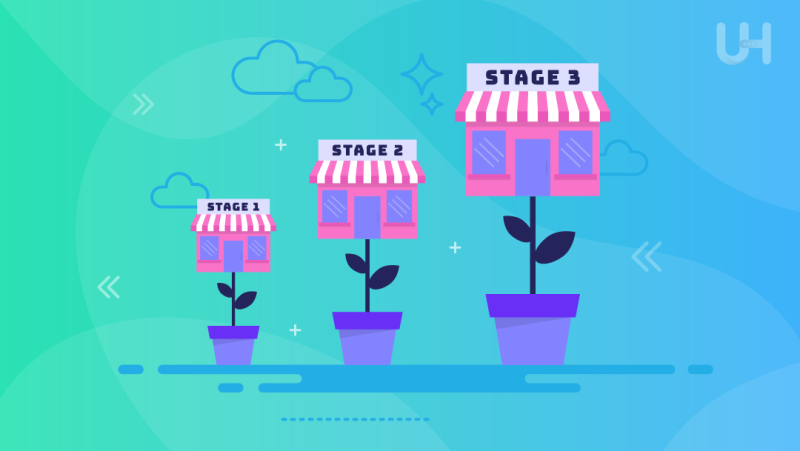Small businesses are the backbone of the global economy, providing employment opportunities and driving innovation in many sectors. However, starting and running a small business can be challenging, and it’s not uncommon for entrepreneurs to encounter a range of obstacles along the way. This article will discuss the five stages of small business development.
Drawing from years of experience working with small businesses and helping entrepreneurs navigate the challenges of business ownership, we will explore the most significant challenges entrepreneurs may face at each stage and provide insights on how to overcome them. Whether you’re a seasoned entrepreneur or just starting, this article is for you.
Stage 1: Decision to start your business
Starting a small business is a big decision, so don’t take it lightly. It requires a lot of thought and planning because a significant investment of time, energy, and money is involved. Many people dream of being their boss, but the fear of failure often holds them back.
In this stage of small business development, the biggest challenge is often having the courage to take that first step. Fear of failure is a common obstacle for many aspiring entrepreneurs. It’s easy to imagine all the things that could go wrong and the potential consequences. However, it’s important to remember that failure is a natural part of the learning process.
Thomas Edison famously said, “I have not failed. I’ve just found 10,000 ways that won’t work.” So, embrace failure as an opportunity to learn and grow. To overcome the fear of failure, imagine the worst-case scenario. In most cases, the consequences are not as dire as we imagine. If your business does not succeed, you can always go back to your previous job or try something else.
Once you’ve decided to start your business, the next step is to spot the right opportunity. It involves conducting market research to determine if there is a demand for your product or service and assessing the competition. Understanding your target market and being able to differentiate yourself from the competition are both crucial.
Develop a business plan that outlines your goals, strategies, and financial projections. A business plan serves as a roadmap for your business and can help you secure financing if needed. During the initial stages of starting a business, understanding your financial options is crucial. One key solution many entrepreneurs turn to is understanding SBA loan programs, which offer various benefits to support small businesses in their growth journey. These loans provide flexible terms and beneficial interest rates, aiding in overcoming the financial hurdles each stage may present. It’s essential to be realistic when developing your business plan and to seek the advice of experts if necessary.
Stage 2: Birth of your business
Once you have decided to start your own business and have a general plan in mind, it is time for the birth of your business. Starting to bring your vision to life and making your business a reality can be an exciting time. However, it can also pose several challenges that may potentially derail your plans. Therefore, it is crucial to be prepared and anticipate any obstacles that may come your way.
One of the most significant problems small business owners face during this stage is the lack of direction. You may feel lost, overwhelmed, and unsure about what steps to take. You may also experience doubt and second-guess your decisions, wondering if you have what it takes to turn your vision into a successful business.
It is crucial to stay focused and maintain a positive mindset during this stage. Remember why you started your business, and keep that goal in mind. You may encounter setbacks and roadblocks, but stay motivated and persistent.
Another challenge is staying organized and keeping track of all the necessary tasks. When starting a business, it is easy to get overwhelmed. It is crucial to prioritize your tasks and focus on the most critical ones. It is also helpful to create a schedule and a to-do list, which can help you stay on track and keep you accountable.
Create a solid foundation for your business by taking the necessary steps, such as setting up your business structure, registering your business, and obtaining any required permits and licenses. You should also choose a name and establish a brand that reflects your vision and values, set up the necessary infrastructure, and develop your products or services.
Finally, it is crucial to start building your network and relationships with customers, suppliers, and other businesses. Establish a presence on social media and create a website.
Even though you may be tempted to use the cheapest shared hosting, don’t do it. Choose affordable VPS hosting instead. Paying upfront for a year, the monthly fee will be just $4.50, and you’ll also receive a free domain! It will be easier to scale your plan as your business grows.
Stage 3:Tough Beginning
Once you have decided to start your business, the next step is to bring your idea to life. Starting a business can be a rollercoaster ride of emotions, and it’s not uncommon for entrepreneurs to experience doubts and setbacks along the way.
In the early days of a business, the biggest challenge is often getting off the ground. You may struggle to secure funding, find a suitable location, hire staff, or attract customers. You may also find yourself juggling many different responsibilities, from marketing to tax accounting to customer service.

One of the most significant challenges at this stage is managing cash flow. New businesses may encounter cash flow problems because expenses accumulate more rapidly than revenues. It is crucial to manage your cash flow properly and have a realistic understanding of your expenses and revenue projections. Accurate and predictable payroll records make it easier to track labor costs and manage cash flow, and tools like an online paystub generator can simplify this process.
Another challenge is staying motivated and focused. It’s easy to get discouraged when things don’t go according to plan or when progress is slow. Once again, remind yourself why you started your business to stay committed to your goals. Make sure your business plan outlines your strategies and financial projections. Break it down into actionable steps and set achievable goals.
Surround yourself with a supportive network. Seek out mentors, advisors, and other entrepreneurs who can offer advice and support. Join networking groups, attend industry events, and connect with others in your community who share your interests. Effective corporate travel can be a helpful solution for attending these business events, ensuring you make the most of your networking opportunities across different locations
Finally, don’t be afraid to make mistakes. Every entrepreneur experiences setbacks and failures along the way of small business development. What’s important is to learn from these experiences and to keep moving forward. Remember that building a successful business takes time, effort, and persistence. The tough beginning is just one stage on the path to success.
Stage 4: Stabilization
After overcoming the initial hurdles and tough beginnings, a small business eventually reaches a point where it can stabilize. The stabilization phase is a time when the company starts to feel comfortable in its niche and can generate consistent revenue. However, it is also a phase where business owners must be cautious not to fall into complacency.
One of the most significant challenges during the stabilization phase is ensuring consistent quality and customer satisfaction. As a business grows, it can become challenging to maintain a high level of service or product quality. To maintain quality and meet customer expectations, business owners must ensure they have the necessary resources and systems in place.
Even if a business has been profitable, managing cash flow still can be challenging. Business owners must prevent issues with late payments, outstanding debts, and other financial challenges that can arise during this phase.
As the business becomes more active, travel for client meetings, conferences, and supplier visits often becomes part of normal operations. Using a business travel credit card can help keep these expenses organized by placing all trip-related costs in one system with clear spending limits and tracking. This makes cash flow easier to monitor and reduces the need for manual reimbursements as the team begins to travel more frequently.
To maintain stability, business owners need to focus on retaining key employees. Employee turnover can be detrimental to the success of a business, especially during the stabilization phase. Tools like an employee turnover calculator can help businesses understand the financial impact of turnover and take steps to address retention issues effectively. Owners must keep their employees motivated and engaged by providing training and development programs, competitive salaries, and benefits packages.
Boosting their success and recognizing their efforts significantly contributes to motivation, and with special gifts and unique crystal pillar trophies you can thank them.
In this phase, you should also prioritize business growth by expanding your product or service offerings, exploring new markets, or investing in marketing and advertising initiatives. While stability is critical, it’s equally important not to become complacent and to continue striving for growth.
When your company grows, VPS hosting may no longer be sufficient. In this case, you will need to move up a level and choose a Virtual Dedicated Server. VDS Hosting is the best hosting for business.
Stage 5: Development
When the small business begins to grow and expand it experiences an increase in sales, customers, and employees. The focus shifts from survival to growth, and the business owner starts to explore new opportunities and take on new challenges.
One of the biggest challenges during the development stage is managing growth. As the business grows, it becomes more complex, and the owner must learn to delegate responsibilities to employees and manage them effectively. The business owner must also make sure that the company has the financial resources to support its growth.
To manage growth effectively, the business owner must develop a clear vision for the future of the company. It includes identifying new markets, developing new products or services, and expanding the customer base. The owner must also establish a strong brand and a positive reputation in the market to attract new customers and retain existing ones.
Another challenge during the development stage is competition. As the business grows, it becomes more attractive to competitors, who may try to copy the company’s products or services. The business owner must be prepared to respond by continually innovating and improving the company’s offerings.
It is a time to focus on building a competent team. The business owner must hire and train employees who can help the company achieve its goals. It includes developing a strong company culture and providing employees with opportunities for growth and advancement. Using a talent acquisition software can help you streamline this hiring process.
For businesses focused on software-as-a-service (SaaS) products, effective SaaS sales recruitment is key to scaling growth. Identifying and bringing on board sales professionals with experience in selling subscription-based services ensures that your team can effectively target and convert leads in a competitive market.
To ensure continued success during the development stage, the business owner must stay focused on the company’s core values and mission by being adaptable and flexible in response to changing market conditions and customer needs. The owner must also continue to invest in the company’s infrastructure, technology, and employees to support growth and expansion.
Conclusion
The 5 stages of small business development are crucial for every entrepreneur to understand. Each stage comes with unique challenges and requires different skills, knowledge, and mindset.

The decision about starting a business requires courage and overcoming the fear of failure. Starting a business demands a clear vision and direction. Starting can be challenging, therefore it is crucial to have persistence and resilience to overcome any obstacles. Finally, you will stabilize your business and focus on efficiency and profitability to ensure the business’s sustainability.
But developing a business never ends. Continuous innovation and improvement are necessary to keep up with the changing market. The moment you stop developing, your business will fail.
The stages I described are not linear. They provide a framework for small business owners to understand where they are in their journey and what they need to do to move forward. Remember that success is not guaranteed, and setbacks and failures are inevitable. However, by understanding the stages of small business development, you can navigate the challenges you will face.
Starting a small business is a challenging but rewarding journey. It requires hard work, dedication, and a willingness to learn and adapt. By taking the time to understand the 5 stages of small business development and preparing for the challenges ahead, you can increase your chances of success and achieve your goals. Remember, the journey may not be easy, but it will be worth it in the end.
If you enjoyed this article, then you’ll love UltaHost hosting platform. Rent a VPS and get 24/7 support from our support team. Our powered infrastructure focuses on auto-scaling, performance, and security. Let us show you the difference! Check out our plans!










